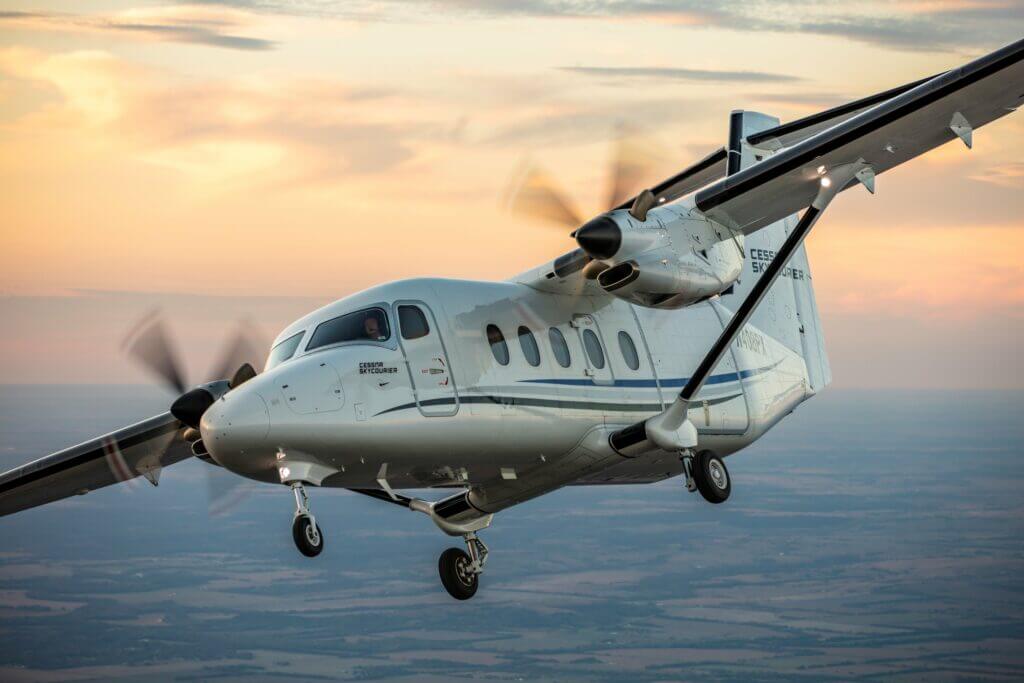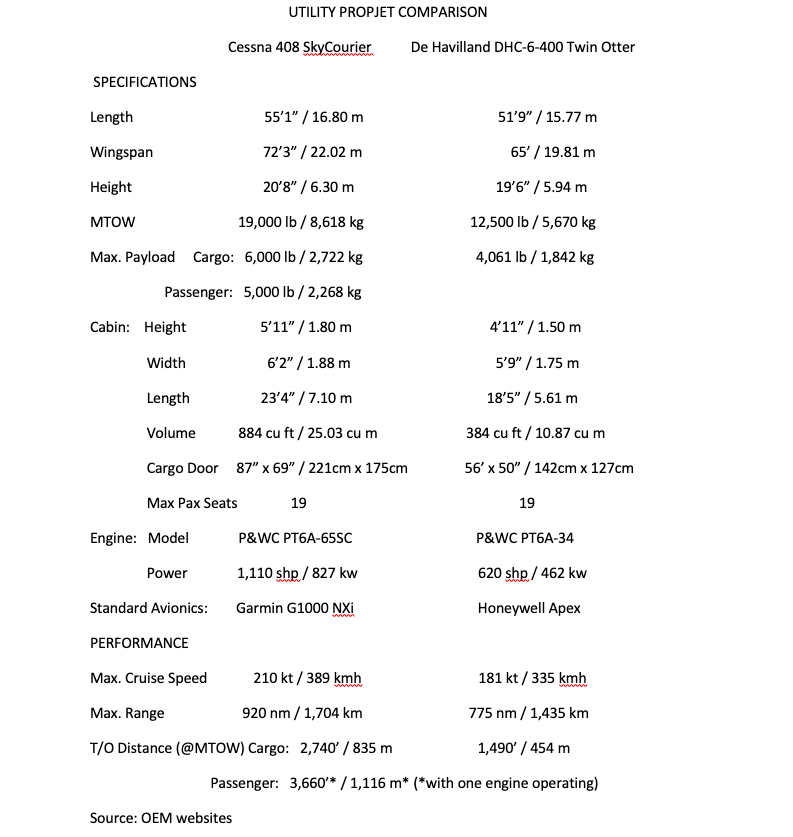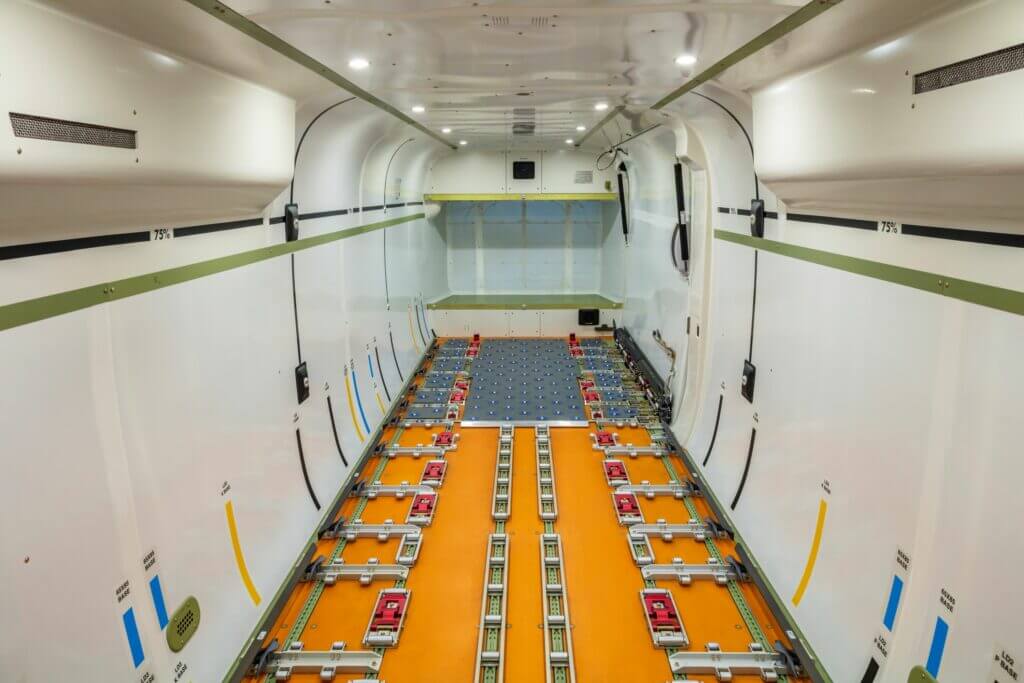Estimated reading time 11 minutes, seconds.
The courier, express and parcel (CEP) segment of the global logistics industry has experienced significant growth during recent decades. The continuing expansion of e-commerce activity by both producers and consumers is expected to result in CEP revenue growth that far exceeds that of the global GDP over the next decade. This will likely require more dedicated freighter aircraft for long-haul, regional and feeder services.

Textron Aviation has decades of experience with the CEP market, particularly with its Cessna 208 family of aircraft. Its most recent product, the Cessna 408 SkyCourier, is aimed at that burgeoning market niche.
Built for purpose
Four decades ago, Federal Express (FedEx) of Memphis, Tennessee believed that the Cessna 208 Caravan would be an ideal package freighter. The single-engine turboprop was the right size required to feed traffic into its hubs from smaller communities. It worked with Cessna to create the 208A Cargomaster, a windowless Caravan configured to carry cargo.
FedEx received the first of 40 aircraft on Feb. 26, 1985. Soon after, FedEx required more lift capacity and collaborated again with Cessna to develop the four-foot-longer 208B Super Cargomaster. The first example from its 260 unit order was delivered on Oct. 31, 1986.
With the continuing expansion of the CEP market, FedEx approached Textron Aviation during the spring of 2017. It desired a package freighter that could haul 6,000 pounds of payload (double the capacity of a 208B) over 200 miles, have a cabin large enough to carry three LD3 containers on a flat floor with rollers, and be equipped with a large cargo door that would enable efficient loading and unloading. The resulting design was a high-wing, twin-engine turboprop that was unpressurized, had fixed landing gear, and could be flown by a single pilot. It soon evolved into the 408 SkyCourier.
When Textron Aviation introduced the aircraft on Nov. 27, 2017, it announced that FedEx had placed a firm order for 50 units and held options for 50 more. At that time, David Cunningham, the president and chief executive officer of FedEx Express, stated: “We worked closely with Textron Aviation to develop the Cessna SkyCourier, which includes several key features that will help us grow our business in small and medium-sized markets. This continues our very successful fleet modernization strategy, which improves our fuel efficiency, reliability and operating costs.”
The prototype SkyCourier first flew on May 17, 2020 and the type was certified by the Federal Aviation Authority (FAA) on Mar. 11, 2022. FedEx received its first aircraft (serial number 408-0003 / N408FE) on May 9, 2022, and it entered revenue service with Mountain Air Cargo on Jan. 3, 2023. Since then FedEx has received an additional 15 SkyCouriers.
Although the SkyCourier was developed as a freighter, its generously proportioned cabin enables the aircraft to perform as a commuter airliner. Its 19 passenger seats are configured three-abreast and its 12 large cabin windows — five on the port side and seven on the starboard side — provide excellent light and visibility. The first passenger model was delivered to Western Aircraft on May 1, 2023. Wearing the livery of Lanai Air, the aircraft shuttles tourists between Honolulu, Hawaii and the island of Lanai.
Otter competition
There are few 19-passenger aircraft currently in production. The most common model is the De Havilland Canada DHC-6-400 Twin Otter. The first DHC-6 flew on May 20, 1965. Since then 995 units have been produced, including 151 of the latest Series 400 variant. A summary of how the SkyCourier compares to the Twin Otter 400, in terms of size, capacity and performance, is provided in the accompanying table.

Over almost 60 years, the Twin Otter has established itself as an accomplished freighter and airliner around the globe. It is particularly known for its ability to operate into and out of challenging airstrips in remote locations, thanks to its short takeoff and landing (STOL) performance.
A review of the specifications presented in the table reveals that the Twin Otter 400 is not really a direct competitor of the SkyCourier. Although both aircraft can accommodate 19 passengers, the Cessna 408 cabin volume is 2.3X greater than that of the DHC-6. This makes sense, given that the SkyCourier was designed to carry LD3 containers. Not a surprise, then, that the 408’s maximum payload of 6,000 pounds is almost 50 per cent greater than that of the Twin Otter.
By year-end 2023, 22 SkyCouriers had been delivered to six operators: Mountain Air Cargo of Denver, NC (11); Empire Airlines of Hayden, ID (5); Bering Air of Nome, AK (2); Everts Air of Fairbanks, AK (1); Kamaka Air of Honolulu, HI (1); and the afore mentioned Western Aircraft of Honolulu (2). Both Mountain Air Cargo and Empire Airlines lease from and operate for FedEx Express.
Brand loyalty is assisting SkyCourier sales, as all of the six operators have had Cessna Caravans in their fleets. Given that there are currently more than 140 Caravans on the Canadian Civil Aircraft Register, there will likely be 408s eventually based across Canada. Latin America stands to become an important market. The National Civil Aviation Authority of Brazil (ANAC) has certified the type. Europe represents additional sales opportunities. Textron Aviation hopes to have the SkyCourier certified by the European Union Aviation Safety Agency (EASA) by mid-2025.

The interview
To better understand the SkyCourier’s market potential, Skies spoke with Juan Escalante, vice-president of Global Sales at Textron Aviation in Wichita, KS.
Skies: The SkyCourier’s key markets appear to be package freight, passenger airline service and corporate shuttles. How many units might be sold over the next decade?
Escalante: While we can’t predict or forecast deliveries, we’re excited about the conversations we’re having with our customers. We’ve seen positive interest all around the world, especially where the SkyCourier’s versatility allows it to provide a tailored solution to unique transportation challenges.
Skies: What are the key performance attributes and operating cost advantages of the 408 over its competitors?
Escalante: Combining high performance with lower operating costs, the cargo and passenger configurations offer single-point pressure refueling that allows faster turnarounds. The 19-passenger version has crew and passenger doors for smooth boarding. Powered by two Pratt & Whitney Canada PT6A-65SC turboprop engines, the aircraft features the McCauley Propeller Systems C779. This heavy-duty and reliable 110-inch aluminum four-blade propeller is full feathering with reversible pitch, and has been designed to enhance the performance of the aircraft while hauling a significant load.
Skies: How long does it take to convert the interior of a passenger configured 408 into a freighter?
Escalante: Using patented quick-release designs for the seats and bulkheads, it takes two people about 45 to 60 minutes to convert a 19-passenger SkyCourier from a passenger configuration into a cargo configuration.
Skies: Can a SkyCourier operate in and out of an unpaved airstrip?
Escalante: An optional gravel kit is available. The SkyCourier was certified to operate from gravel and dirt runways in December 2022.
Skies: What is the typical price for a new SkyCourier?
Escalante: The 2024 base price of a passenger configured 408 is US$8.35 million, while a cargo variant is priced at US$7.75 million.
Skies: Could a 408 be equipped with amphibious floats?
Escalante: We do not have plans to equip the SkyCourier with floats at this point, but we’ll continue to evaluate the possibility should there be interest.








